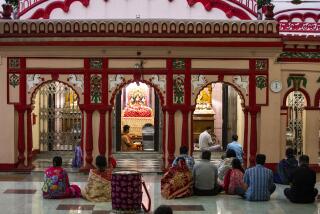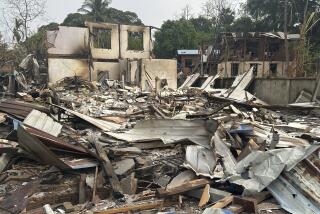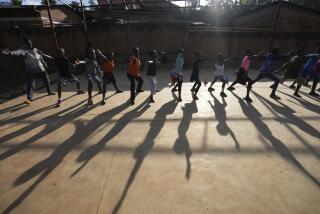Civilians Are Often Targets in Sri Lanka’s Civil War : South Asia: Massacre is called a form of ‘ethnic cleansing’ in bloody campaign for Tamil homeland.
PALLIYAGODELLA, Sri Lanka — They attacked before dawn, rifles and machetes in their hands and murder in their hearts.
For two hours, the Tamil guerrillas shot or hacked to death 143 Muslim men, women and children, plus 20 soldiers and police. Eighty-eight other civilians were wounded, many critically. It was, officials said, the worst single day of slaughter in this South Asian nation’s already savage nine-year civil war.
“When I heard firing, I ran to a shed with my family. But they came in and shot us,” said Fatima Warasaikama, 30, a rail-thin woman wearing a torn yellow sari and bloody bandage on her left shoulder at the Polonnaruwa base hospital. “My husband and 7-year-old son were killed.”
“They said, ‘Don’t run, we are here to protect you.’ Then they shot us,” said Adambaba Dawood, 48, a raspy-voiced farmer who wore a full cast on his left leg. Two sons were shot in the head and killed, he said.
“We are harmless,” agreed Meerakanai Sathumarikar, 26, a barefoot farmer who lost seven family members. “Why do they kill us?”
The massacre last month in this remote farming village by separatist rebels called the Liberation Tigers of Tamil Eelam has brought more questions than answers about a seemingly intractable ethnic conflict in which civilians are not just killed in the cross-fire, but are frequently the targets as well.
Largely forgotten by the world and ignored by the tourists and business people who flock to Sri Lanka’s palm-lined beaches and fast-growing economy, the Tigers’ bloody campaign for an independent Tamil homeland in the country’s north and east has little hope of quick solution.
Instead, the Sinhalese-dominated government of President Ranasinghe Premadasa is locked in a political and military stalemate with the rebels. The Tigers effectively control one-third of the country, the government two-thirds. Neither side can claim victory, and attempts to halt the bloodletting are tenuous at best.
“We’re in a situation where no one is really willing to compromise,” said Rohan Edrisinha, a University of Colombo law professor who is working with a parliamentary panel seeking peace talks. “And that makes a settlement very unlikely.”
The latest carnage doesn’t help. A government spokesman said the attack on civilians was designed to force the army to pull troops back from the north and ease pressure on the besieged Tiger stronghold there. But other analysts say the Tigers are simply trying to eliminate all Muslims and other non-Tamils from their claimed homeland and border areas.
“We’re calling it ‘ethnic cleansing,’ ” said one Western diplomat, using a term commonly applied to the campaign by Serbs to drive out other ethnic groups from Serbian-occupied territory in some of the former Yugoslav republics.
The estimated 5,000 to 7,000 Tigers are often compared to Peru’s Sendero Luminoso guerrillas for their fanaticism. They have kept the 77,000-strong armed forces off guard and overextended with brutal attacks, terrorist bombings and assassinations since a cease-fire collapsed in June, 1990.
In May, India accused Tiger chief Vellupillai Prabhakaran of assassinating Indian Prime Minister Rajiv Gandhi a year before. Another Tiger bomb last year killed Sri Lanka’s defense minister and 28 others in Colombo, the capital. Still another wrecked the Defense Ministry’s operations center.
Despite repeated military assaults, the Tigers still control most of the northern peninsula, where they rule the port of Jaffna and at least 800,000 civilians. The only real Tiger defeat came when the army retook Elephant Pass last fall, choking a key northern supply route and killing hundreds of rebels in one of the war’s few set battles.
But on Aug. 8 this year, the military was devastated when a huge explosion, apparently caused by a land mine, killed the army’s most popular leader and chief strategist, Maj. Gen. Denzil Kobbekaduwa, and nine other officers. The blast wiped out most of the army’s northern field command and some of its most experienced combat officers.
“They were the best available officers, and the most respected and loved,” said Col. Sarath Munesinghe, an army spokesman. “Our troops were demoralized. So it takes some time to get back.”
Security forces already have lost nearly 900 troops this year, the bloodiest year yet. In all, an estimated 20,000 people have been killed since 1983, and at least 650,000 refugees have been forced from their homes. Human rights groups cite widespread abuses on both sides, although the number of reported disappearances, executions and torture cases by government forces has fallen.
Tamils, who are mostly Hindu, make up 18% of Sri Lanka’s 17 million people. Tamils tell of systematic discrimination by the majority Sinhalese, who are mostly Buddhist. Muslims make up 7% of the population.
In southern and central Sri Lanka, the three groups live in uneasy peace. “There are still very few linkages, very few bridges being built across communities in Sri Lanka,” said Neelan Tiruchelvam, a prominent Tamil lawyer and political analyst.
The government hopes an economic boom will help. New factories produce products ranging from batik garments to Walt Disney toys. A hotly promoted export fair this month hopes to attract 1,500 overseas buyers. Officials predict that a near-record 400,000 tourists, mostly Europeans, will pass through Colombo’s gleaming new airport this year, drawn by pristine beaches, elephant reserves and dramatic jungle-clad ruins.
But the war grinds on in the north and east. Villages are abandoned to stray dogs and crows. Homes are empty, shops destroyed, fields left fallow. Army troops man roadblocks built of logs, sandbags and tires. Each vehicle and passenger is repeatedly searched for contraband. Convoys of jeeps, field artillery and armored personnel carriers roar by.
In Batticaloa, a mostly Tamil east coast port, heavily armed troops patrol mostly empty streets and peer out from pillboxes and barricades beside burned-out buildings. Shops are open, but they have few goods. Bicycles far outnumber cars on the road. Tamil residents complain of arbitrary arrests, beatings and harassment by the military.
“People are going through immeasurable sufferings,” said Pararajasingham Joseph, a Batticaloa politician with close ties to the Tigers. He said 40% of the city supports the rebels. “They are fighting for a cause,” he said.
But the cause is hard to find in Palliyagodella.
In last month’s attack, an estimated 150 Tigers came from two sides, storming the village police and army post, then easily topping the waist-high wall and three log-lined bunkers. Firing automatic weapons and tossing grenades, the guerrillas quickly killed eight soldiers and 12 police officers and ransacked the post for weapons.
The village is abandoned today except for police patrols. Bulldozers buried the dead under three long mounds of red earth behind a bullet-pocked brick wall. A single strip of white mourning cloth hangs limp in the still air. Flies buzz at dried blood in the empty, broken houses.
More to Read
Sign up for Essential California
The most important California stories and recommendations in your inbox every morning.
You may occasionally receive promotional content from the Los Angeles Times.











